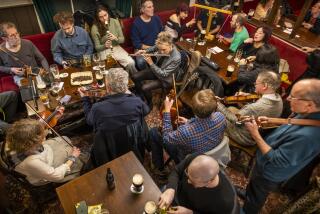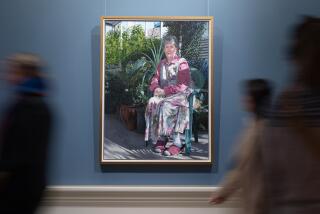Between Pints, Purists Pine for Loss of Dublin’s ‘Traditional’ Pubs
- Share via
DUBLIN, Ireland — Michael Smith trudges down the quays of this thirsty city in the footsteps of Joyce, Yeats and Behan, a soft rain dampening his sweater, a look of disgust on his face.
“They’ve hijacked Joyce and Collins too,” Smith mourns, gesturing at the cheap prints of poets and rebels on the walls of yet another pub.
“And nothing is as it seems.”
Through the narrow streets he walks, the yeasty smell of Guinness drifting over the cobblestones and across the muddy waters of the River Liffey. There’s a pub tucked into every corner here, solid, familiar-looking places with names that harken to history and character: The Auld Dubliner. The Norseman. The Foggy Dew.
It could be a scene from 150 years ago--untouched, charming, real.
But push through the Victorian swing doors of many of the pubs, and authenticity vanishes along with the dockside smell.
Budweiser flows from the taps, music blares from jukeboxes, and big-screen televisions are as likely to be airing the latest American football game as the Irish hurling final. Theme bars seem to have sprung up almost overnight, with names like the Thunderbird Cafe, the Wall Street Cafe and the Allsports Cafe. In one glittering emporium, a Harley-Davidson motorbike revolves around a red neon stand directly over the Guinness tap.
For every pub going glitzy, another is striving to be “traditional,” sticking old bits of plows on the walls and lighting up fake peat fires.
“Tourists come looking for tradition, and what they get is second-rate and sham,” Smith snorts.
Smith is no beer-sodden poet lamenting the loss of the last decent pint. He’s a 31-year-old lawyer turned cultural crusader who spends his days renovating historic homes and working for An Taisce, a national preservation organization.
“Taisce” means treasure in Irish. Smith and others are convinced that one of the most precious treasures of all--the Dublin pub--is vanishing before their eyes.
They were once the watering holes of James Joyce and Patrick Kavanagh and Brendan Behan--warm, smoky places of dark-wood “snugs” and ornate brass lamps, where barmen pulled creamy pints with the same loving skill with which their customers drank them. In the 1,000 or so pubs in Dublin, poets mused and rebels plotted and whiskey flowed freely along with the craic--Irish for a rare old time.
Today the snugs, comfortable cubbyholes with leather seats and stained glass, are being ripped out and shipped off to London and New York and Sydney, where ready-made “traditional” Irish pubs are all the rage. The musty old ads for Players cigarettes and Powers whiskey are going too.
Even older establishments are polishing up their past, daubing nicotine stains on newly painted ceilings once darkened by decades of cigarette smoke. Smoked salmon and banoffi, a trendy banana and toffee tart, are now served in places that until recently could barely come up with a ham sandwich.
“Twee,” Smith scoffs. “Expensive, contrived and chic.”
Pub owners say they have little choice. Times are changing. The economy is booming. Young people aren’t emigrating in droves as they did for decades. They have jobs and money and fancy tastes from their travels abroad.
“People want a level of service that pubs never offered before--food and entertainment and air-conditioning,” says T.P. Smith, owner of the 122-year-old Auld Dubliner, which was recently recast in chic-traditional.
Smith paid a contractor for the old pictures and dressers that decorate the walls, and doesn’t know if they are authentic. But they look tarnished enough to pass for history, and he’s happy with the result. He added more televisions and a function room upstairs to cater to another new trend--stag parties from overseas that rent Irish pubs for the night.
And he commissioned a mural on the side of the pub--a life-size painting of a boozy old geezer in a raincoat, the Evening Herald poking out of his pocket, a scruffy dog at his feet. It’s a hit with the tourists, who line up to take photographs beside the original “Auld Dub.”
“It’s the way pubs are going these days,” he says. “We have to keep up with the change.”
You can feel the change in the air--hotels and apartment blocks and cell phones sprouting all over the city that natives still call a town.
Nowhere is the commercial buzz more apparent than in Temple Bar, a kind of left-bank Bohemian enclave south of the Liffey that until six years ago was a run-down stretch of derelict buildings with little hope for its future.
In the early 1990s the Irish government, with help from the European Union, sank about $55 million into developing a residential and entertainment district that bills itself as “the cultural center of Europe.” The streets were paved with cobblestones, and dozens of “traditional” pubs opened alongside boutiques, art galleries and restaurants featuring everything from Mexican to Mongolian food.
“It’s brilliant, what’s happening,” says Eileen Gleeson, spokeswoman for the Irish Vintners Assn. “People are beginning to recognize once and for all that Ireland has a pub culture and it is a good thing that should be nurtured and developed.”
Gleeson, whose family owns a pub in the Dublin suburbs, has seen the changes firsthand. She still remembers the day in the 1970s when her father exclaimed in horror at seeing a woman drinking a pint in the “men-only” section of his bar. Back then it was a classic cozy “local,” with coal fires, bartenders who knew everyone and a corner table reserved for the neighborhood curmudgeon.
Today the fires are artificial, a giant TV screen hangs in the new expanded bar and the curmudgeon long ago passed on.
“It’s all money now, no character anymore,” groans veteran barman Louis Brennan as he pulls a round of pints at the Brazen Head, a creaky 12th-century coachman’s inn named for a redheaded woman who found herself on the wrong side of an English cannon.
There is little purists can do but lament. An Taisce is only an advisory body and can’t enforce preservation of old buildings. It tends to focus on buildings larger and more historically significant than pubs. And even when preservation orders are enforced, they usually affect only the facade, not the inside.
Eamonn Casey, who has written books about Dublin pubs, says modernization was inevitable. Pubs can turn $60,000 in sales a week if they serve up a decent bit of food and tradition, he says. Why shouldn’t they spruce themselves up?
Still, he criticizes the most glaring make-overs, notably the Bailey, which until a few years ago was one of the most fashionable pubs in Dublin. It was here that Charles Stuart Parnell held court as the “uncrowned king of Ireland,” campaigning to end British rule. Here, Oliver St. John Gogarty is said to have introduced Joyce to drink.
Today, in what Casey calls “an act of cultural desecration of the first magnitude,” the bar is two-thirds smaller and the mirrors and luxurious carpets are gone.
Across the road is Davy Byrnes, where the fictional Leopold Bloom of Joyce’s “Ulysses” munched his famous Gorgonzola sandwich and sipped his glass of burgundy.
“Nice quiet bar,” Joyce wrote in “Ulysses.” “Nice piece of wood in that counter. Nicely planed. Like the way it curves there.”
The curve is still there, but the bar is topped with marble now, and the lights shine brightly for the tourists.
“In many ways what is lost is what was most important and meaningful about the Dublin pub: good cheer and camaraderie and wit and begrudgery and intelligence and friendliness and charm,” says Michael Smith. “It was an amazing institution.”
Some say it still is--if you look hard enough. Drop into the Old Stand of a misty Thursday evening and you’ll hear talk of politics and rugby and literature. You’ll find old-timers who remember Behan, the self-described “drinker with a writing problem,” and poet Patrick Kavanagh. And, inevitably, you’ll catch a debate about the future of drinking in Dublin.
“At the end of the day, what gives a pub its character is its people,” says Bob Stuart, knocking back pints with Michael Kelly. “That’s what the pub culture of Ireland is all about.”
“Not in Temple Bar,” Kelly argues. “That’s pseudo. It’s not real Irish culture at all.”
“Sure, after six pints it doesn’t matter where you’re drinking,” chimes in a stranger from the table next to them.
“Ah, you’re right there.”
“Time, ladies and gentlemen,” warns the barman as the closing hour approaches and the three contemplate another round.
“To hell with poverty, history and change,” Stuart booms. “Let’s have another for the road.”
More to Read
Sign up for The Wild
We’ll help you find the best places to hike, bike and run, as well as the perfect silent spots for meditation and yoga.
You may occasionally receive promotional content from the Los Angeles Times.






